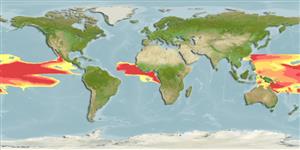>
Beryciformes (Sawbellies) >
Cetomimidae (Flabby whalefishes)
Etymology: Rhamphocetichthys: Greek, rhamphos = bill, peak + Greek, ketos = marine monster, whale + Greek, ichthys = fish.
Eponymy: Dr Jay Mathers Savage (d: 1928) is an American herpetologist and educator who is known particularly for his work on the herpetofauna of Central America. [...] (Ref. 128868), visit book page.
Environment: milieu / climate zone / depth range / distribution range
Écologie
marin bathypélagique; profondeur 0 - 2100 m (Ref. 9791). Deep-water; 25°N - 25°S
Pacific Ocean: Coral Sea and Gulf of California. Also known from the Eastern Central Atlantic.
Taille / Poids / Âge
Maturity: Lm ? range ? - ? cm
Max length : 110 cm SL mâle / non sexé; (Ref. 35509)
Description synthétique
Clés d'identification | Morphologie | Morphométrie
Épines dorsales (Total) : 0; Rayons mous dorsaux (Total) : 15 - 17; Épines anales: 0; Rayons mous anaux: 15 - 17; Vertèbres: 43 - 45.
All captures were made with open nets fishing (Ref. 9791). Minimum depth from Ref. 58018.
Life cycle and mating behavior
Maturité | Reproduction | Frai | Œufs | Fécondité | Larves
Paxton, J.R., 1989. Synopsis of the whalefishes (family Cetomimidae) with descriptions of four new genera. Records of the Australian Museum 41:135-206. (Ref. 9791)
Statut dans la liste rouge de l'IUCN (Ref. 130435: Version 2024-1)
Menace pour l'homme
Harmless
Utilisations par l'homme
Outils
Articles particuliers
Télécharger en XML
Sources Internet
Estimates based on models
Preferred temperature (Ref.
123201): 4.7 - 15.1, mean 7.8 °C (based on 126 cells).
Phylogenetic diversity index (Ref.
82804): PD
50 = 1.0000 [Uniqueness, from 0.5 = low to 2.0 = high].
Bayesian length-weight: a=0.00389 (0.00180 - 0.00842), b=3.12 (2.94 - 3.30), in cm total length, based on all LWR estimates for this body shape (Ref.
93245).
Résilience (Ref.
120179): Faible, temps minimum de doublement de population : 4,5 à 14 années (Preliminary K or Fecundity.).
Fishing Vulnerability (Ref.
59153): Very high vulnerability (81 of 100).
